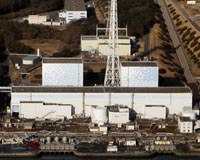 |
Kalinin Nuclear Power Plant, Russia (AFP) March 18, 2011 Anxious Russian nuclear engineers swung open the doors Friday to the atomic power plant nearest Moscow to prove that its four reactors would never suffer the type of event witnessed in Japan. The Kalinin nuclear power plant sits just 330 kilometres (200 miles) northwest of Moscow -- a sprawling white cement structure whose four water cooling towers shoot up almost directly upwind from the Russian capital. But while strategically located in one of the most densely-populated parts of Russia, the plant has still suffered much the same fate as the other nine stations at Russia's current disposal. Its second reactor was commissioned the same year as the 1986 Chernobyl nuclear power accident struck what is now Ukraine, spewing deadly waste over much of Europe and freezing the Soviet Union's vast nuclear ambitions. Kalinin's third reactor was not launched until 2004 and its fourth is being built at the same time as a horrified world watches Japan scramble against time in a desperate bid to save the Fukushima plant from a major disaster. Facing a swarm of journalists bused in especially by the Rosatom atomic energy corporation, Kalinin's engineers read out a long list of their plant's advantages to those being built around the world by the US power giant GE. "This is one of the safest reactors in the world. Fukushima is nothing like it at all," said Kalinin engineer Oleg Rozhkov. "Plus, nuclear power plants are the only ones being built here these days. Electric and other stations are constantly having problems." Besides installing a new reactor at Kalinin, which should go on line early next year, Russia is also expanding and building five other stations in a bid to boost their share of the local energy market from the current 15 percent. The drive would enable Russia to export even more of its energy riches while continuing to provide cut-rate electricity to households that have been used to the privilege since the early Soviet era. None of Russia's nuclear power plants sit on the types of fault lines that hurt Fukushima in Japan. But the trauma of Chernobyl still haunts the industry, with Russia taking extra steps to ensure that its plants are built-in with added layers of protection that can cool the reactors even when the power goes out. The VVER-1000 reactor of the type being built in Kalinin comes with modern advantages such as horizontal steam generators that experts say can hold more water in case of an emergency. Should water pressure suddenly drop during an accident, Kalinin engineers say the plant's "passive" emergency system can fill the reactors with cold water even when the power goes out. "It operates on the principle of higher and lower water pressures," said the power plant's deputy chief engineer Igor Bogomolov. "No electricity needed." These defence mechanisms and the industry's growing importance to Russia's economy mean that the plants like the one at Kalinin will probably continue dotting the countryside for many decades to come. Rosatom declares on its website that "atomic energy is one of the most important sectors of Russia's economy" and while the government has ordered a top-down industry review, few expect stations to be mothballed any time soon. Kalinin engineers, however, seemed genuinely worried about their own futures and are following the events in Japan with growing alarm. "Of course people are worried about what happened. We do not want to be left unemployed," said Andrei Ganchev, a chief shift engineer at the plant. "This is a small town and this place is the main employer." The Kalinin plant is responsible for about a quarter of the Tver region's entire economy, employing 3,322 people permanently and more than 3,300 other workers who are currently putting up the plant's fourth block. Average monthly pay at the plant, meanwhile, is around $1,500 -- well above the average for rural Russia. "Specialists from all over the country come to work here," engineer Rozhkov said. "They are building it quickly and paying well."
Share This Article With Planet Earth
Related Links Nuclear Power News - Nuclear Science, Nuclear Technology Powering The World in the 21st Century at Energy-Daily.com
 GE defends nuclear plant design
GE defends nuclear plant designWashington (AFP) March 18, 2011 General Electric defended its 40 year old Mark 1 reactors at the center of Japan's nuclear crisis Friday, saying that early questions about reactor's safety had long been addressed. GE rejected recent reports of possible design weaknesses in the Mark 1, which accounts for five of the six reactors at the Fukushima plant, threatened with meltdowns after cooling systems failed. "The Mark I ... read more |
|
| The content herein, unless otherwise known to be public domain, are Copyright 1995-2010 - SpaceDaily. AFP and UPI Wire Stories are copyright Agence France-Presse and United Press International. ESA Portal Reports are copyright European Space Agency. All NASA sourced material is public domain. Additional copyrights may apply in whole or part to other bona fide parties. Advertising does not imply endorsement,agreement or approval of any opinions, statements or information provided by SpaceDaily on any Web page published or hosted by SpaceDaily. Privacy Statement |